Industry 4.0 and functioning of supply chains
VerifiedAdded on 2022/12/21
|11
|2912
|2
AI Summary
This report evaluates the impact of Industry 4.0 on supply chain operations of IQ EQ Ltd Software. It discusses the concept of Industry 4.0, the changes it brings to manufacturing and supply chains, and the specific case of IQ EQ Ltd Software. The report also explores the implementation of Industry 4.0 in supply chains and the future trends in the industry.
Contribute Materials
Your contribution can guide someone’s learning journey. Share your
documents today.
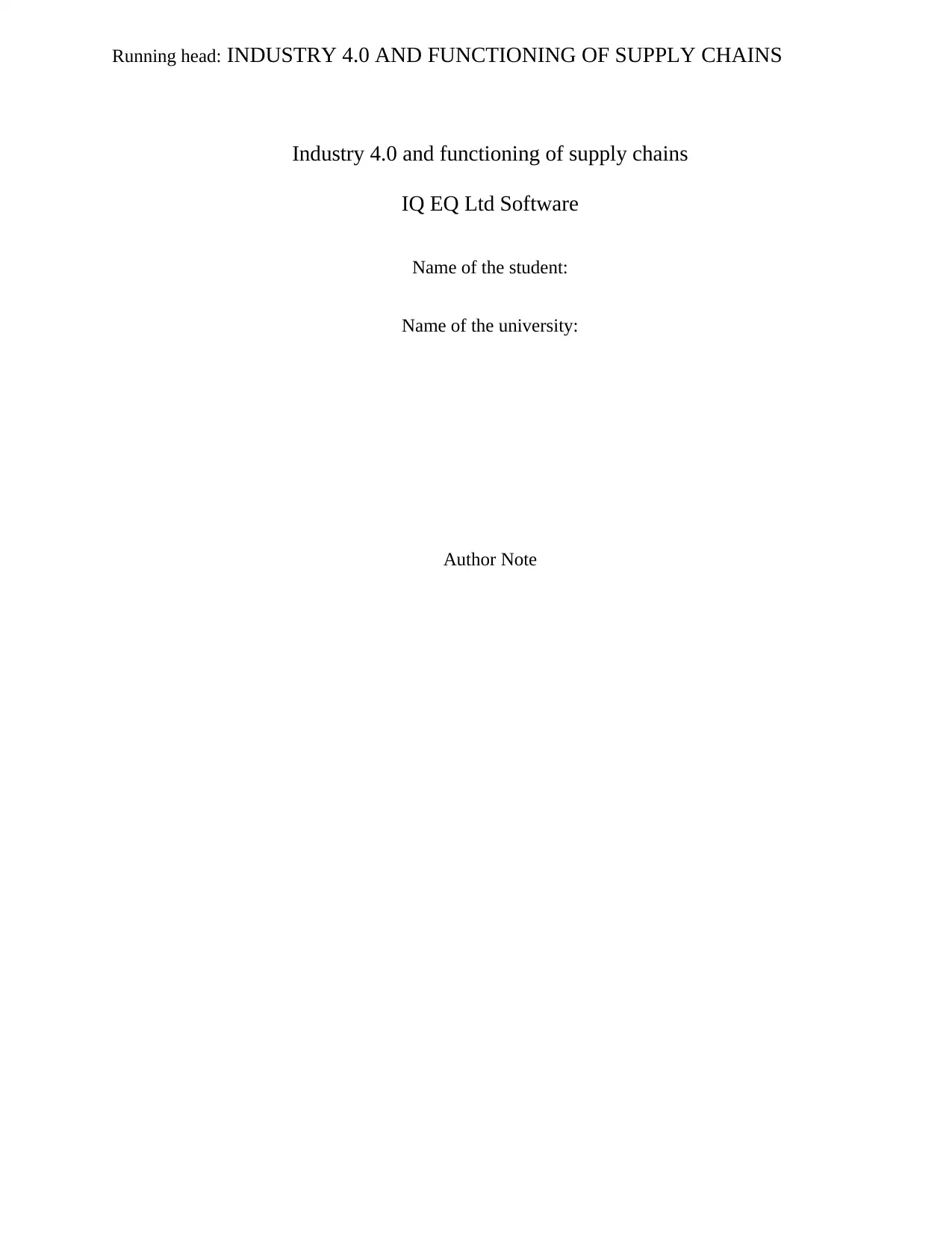
Running head: INDUSTRY 4.0 AND FUNCTIONING OF SUPPLY CHAINS
Industry 4.0 and functioning of supply chains
IQ EQ Ltd Software
Name of the student:
Name of the university:
Author Note
Industry 4.0 and functioning of supply chains
IQ EQ Ltd Software
Name of the student:
Name of the university:
Author Note
Secure Best Marks with AI Grader
Need help grading? Try our AI Grader for instant feedback on your assignments.
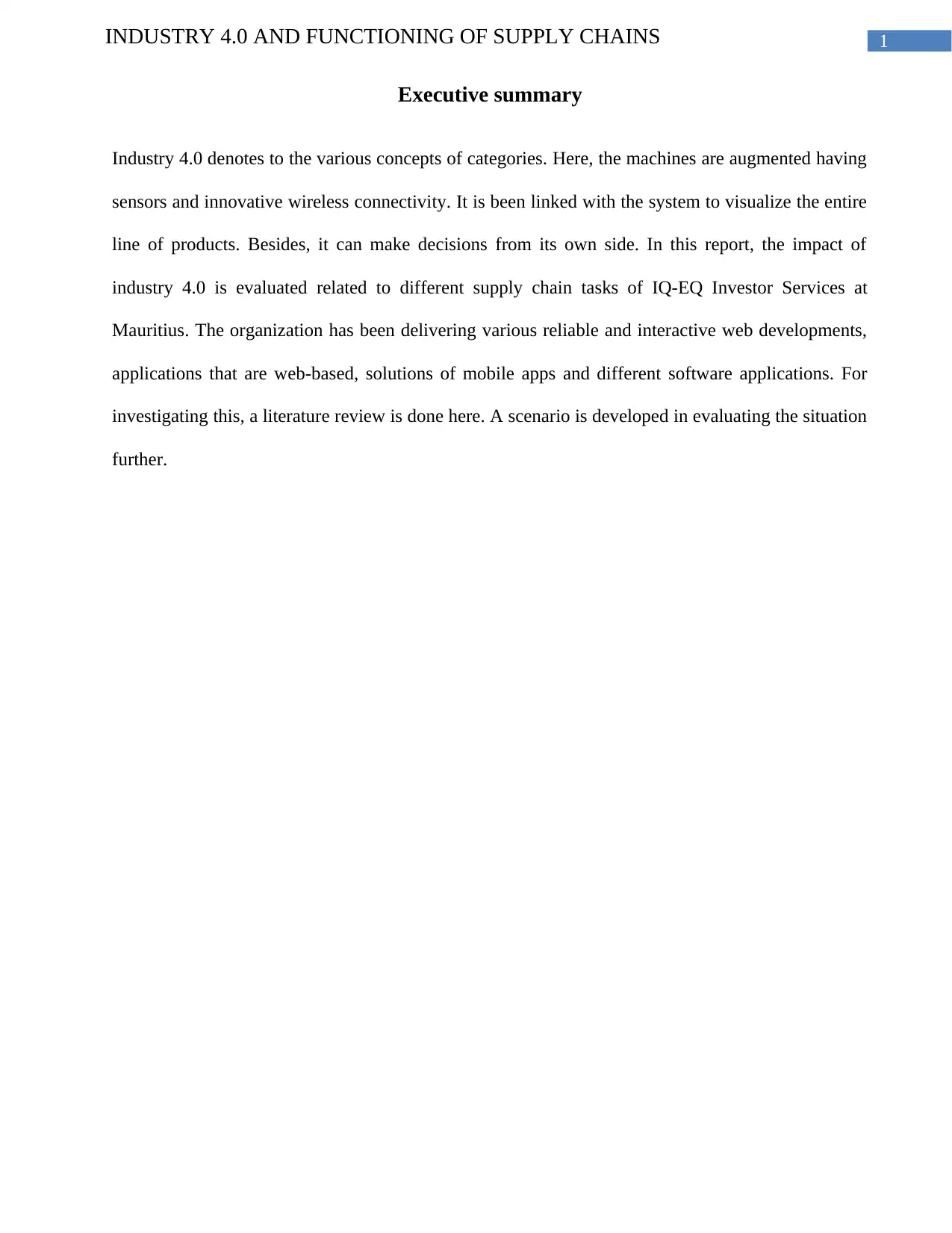
1INDUSTRY 4.0 AND FUNCTIONING OF SUPPLY CHAINS
Executive summary
Industry 4.0 denotes to the various concepts of categories. Here, the machines are augmented having
sensors and innovative wireless connectivity. It is been linked with the system to visualize the entire
line of products. Besides, it can make decisions from its own side. In this report, the impact of
industry 4.0 is evaluated related to different supply chain tasks of IQ-EQ Investor Services at
Mauritius. The organization has been delivering various reliable and interactive web developments,
applications that are web-based, solutions of mobile apps and different software applications. For
investigating this, a literature review is done here. A scenario is developed in evaluating the situation
further.
Executive summary
Industry 4.0 denotes to the various concepts of categories. Here, the machines are augmented having
sensors and innovative wireless connectivity. It is been linked with the system to visualize the entire
line of products. Besides, it can make decisions from its own side. In this report, the impact of
industry 4.0 is evaluated related to different supply chain tasks of IQ-EQ Investor Services at
Mauritius. The organization has been delivering various reliable and interactive web developments,
applications that are web-based, solutions of mobile apps and different software applications. For
investigating this, a literature review is done here. A scenario is developed in evaluating the situation
further.
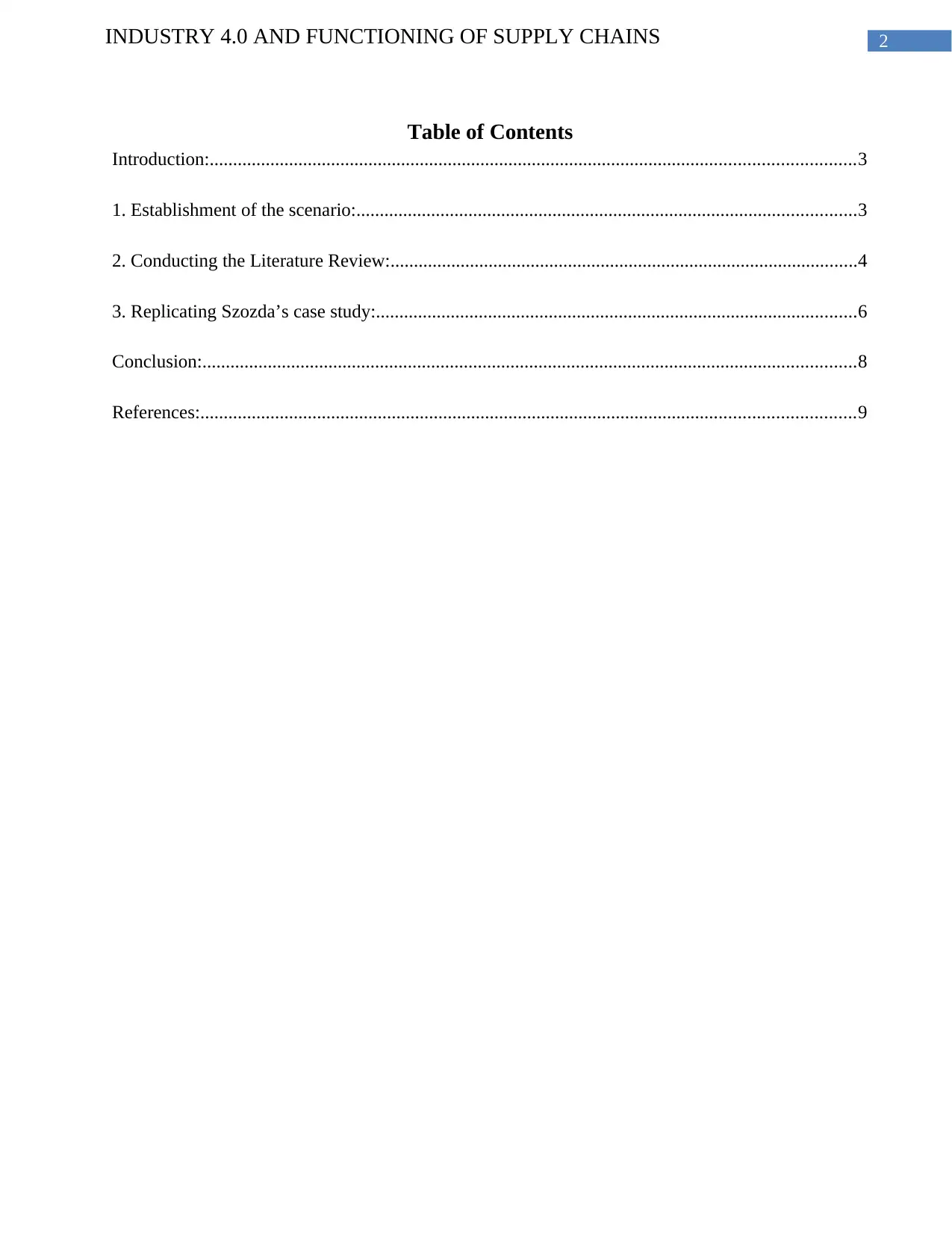
2INDUSTRY 4.0 AND FUNCTIONING OF SUPPLY CHAINS
Table of Contents
Introduction:..........................................................................................................................................3
1. Establishment of the scenario:...........................................................................................................3
2. Conducting the Literature Review:....................................................................................................4
3. Replicating Szozda’s case study:.......................................................................................................6
Conclusion:............................................................................................................................................8
References:............................................................................................................................................9
Table of Contents
Introduction:..........................................................................................................................................3
1. Establishment of the scenario:...........................................................................................................3
2. Conducting the Literature Review:....................................................................................................4
3. Replicating Szozda’s case study:.......................................................................................................6
Conclusion:............................................................................................................................................8
References:............................................................................................................................................9
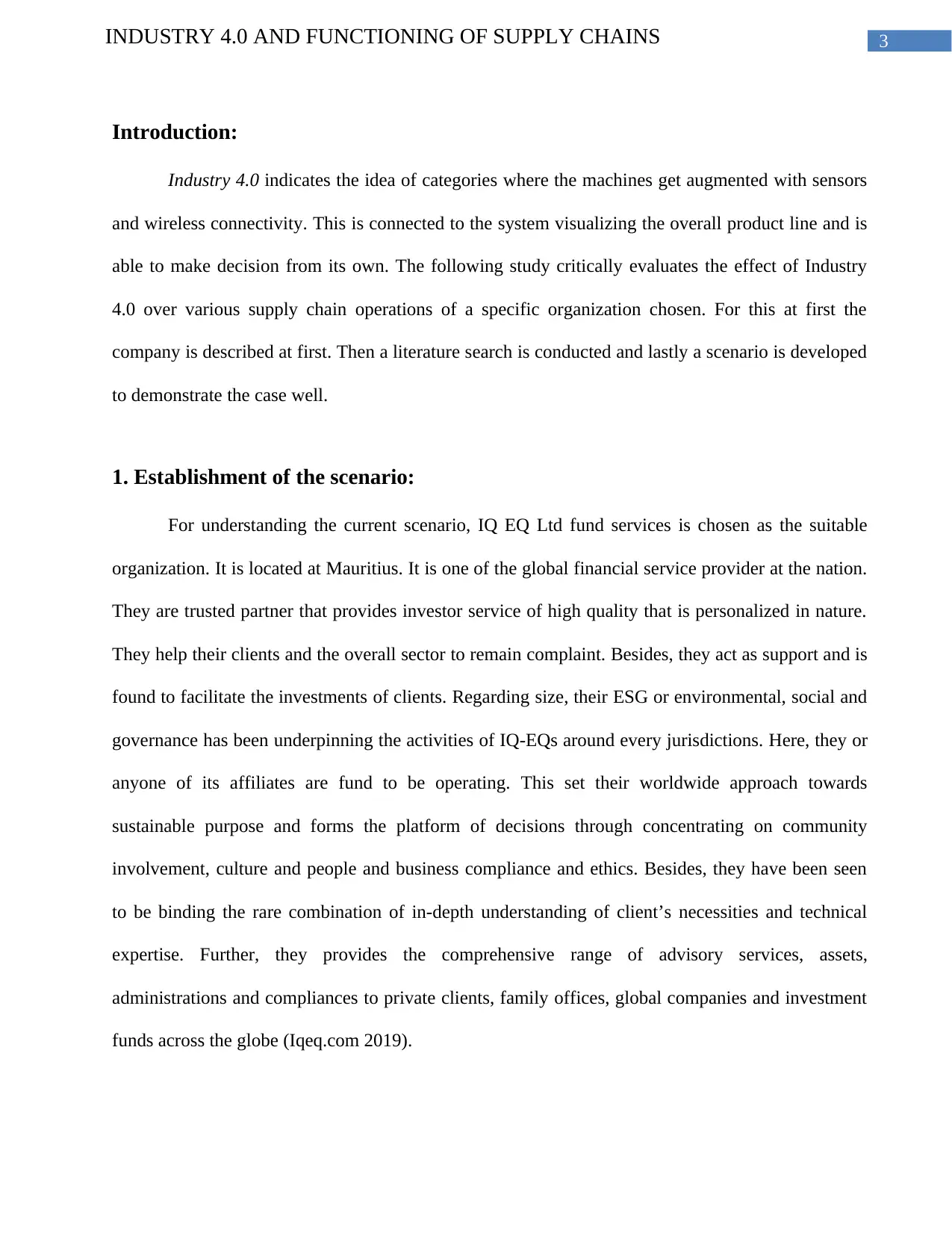
3INDUSTRY 4.0 AND FUNCTIONING OF SUPPLY CHAINS
Introduction:
Industry 4.0 indicates the idea of categories where the machines get augmented with sensors
and wireless connectivity. This is connected to the system visualizing the overall product line and is
able to make decision from its own. The following study critically evaluates the effect of Industry
4.0 over various supply chain operations of a specific organization chosen. For this at first the
company is described at first. Then a literature search is conducted and lastly a scenario is developed
to demonstrate the case well.
1. Establishment of the scenario:
For understanding the current scenario, IQ EQ Ltd fund services is chosen as the suitable
organization. It is located at Mauritius. It is one of the global financial service provider at the nation.
They are trusted partner that provides investor service of high quality that is personalized in nature.
They help their clients and the overall sector to remain complaint. Besides, they act as support and is
found to facilitate the investments of clients. Regarding size, their ESG or environmental, social and
governance has been underpinning the activities of IQ-EQs around every jurisdictions. Here, they or
anyone of its affiliates are fund to be operating. This set their worldwide approach towards
sustainable purpose and forms the platform of decisions through concentrating on community
involvement, culture and people and business compliance and ethics. Besides, they have been seen
to be binding the rare combination of in-depth understanding of client’s necessities and technical
expertise. Further, they provides the comprehensive range of advisory services, assets,
administrations and compliances to private clients, family offices, global companies and investment
funds across the globe (Iqeq.com 2019).
Introduction:
Industry 4.0 indicates the idea of categories where the machines get augmented with sensors
and wireless connectivity. This is connected to the system visualizing the overall product line and is
able to make decision from its own. The following study critically evaluates the effect of Industry
4.0 over various supply chain operations of a specific organization chosen. For this at first the
company is described at first. Then a literature search is conducted and lastly a scenario is developed
to demonstrate the case well.
1. Establishment of the scenario:
For understanding the current scenario, IQ EQ Ltd fund services is chosen as the suitable
organization. It is located at Mauritius. It is one of the global financial service provider at the nation.
They are trusted partner that provides investor service of high quality that is personalized in nature.
They help their clients and the overall sector to remain complaint. Besides, they act as support and is
found to facilitate the investments of clients. Regarding size, their ESG or environmental, social and
governance has been underpinning the activities of IQ-EQs around every jurisdictions. Here, they or
anyone of its affiliates are fund to be operating. This set their worldwide approach towards
sustainable purpose and forms the platform of decisions through concentrating on community
involvement, culture and people and business compliance and ethics. Besides, they have been seen
to be binding the rare combination of in-depth understanding of client’s necessities and technical
expertise. Further, they provides the comprehensive range of advisory services, assets,
administrations and compliances to private clients, family offices, global companies and investment
funds across the globe (Iqeq.com 2019).
Secure Best Marks with AI Grader
Need help grading? Try our AI Grader for instant feedback on your assignments.
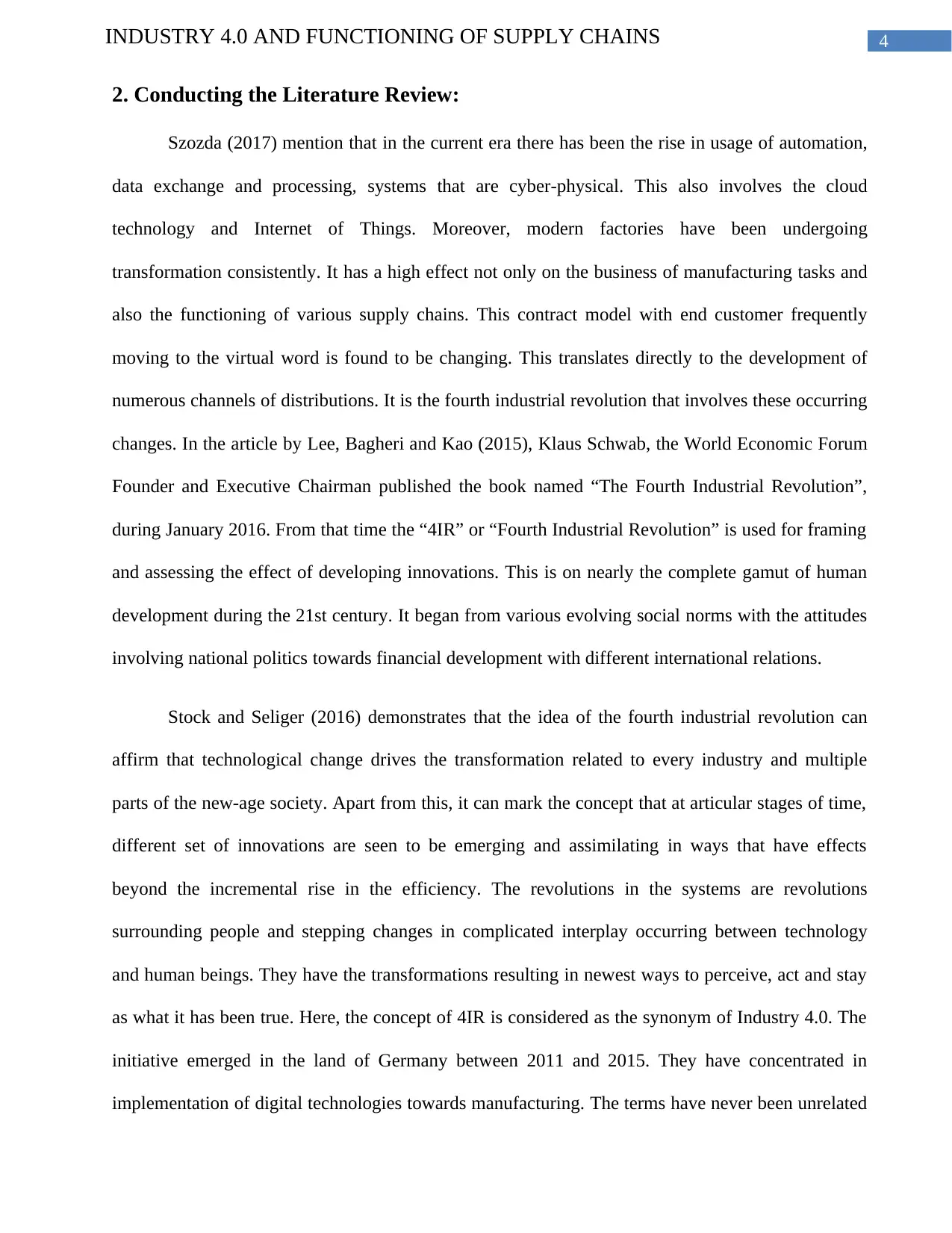
4INDUSTRY 4.0 AND FUNCTIONING OF SUPPLY CHAINS
2. Conducting the Literature Review:
Szozda (2017) mention that in the current era there has been the rise in usage of automation,
data exchange and processing, systems that are cyber-physical. This also involves the cloud
technology and Internet of Things. Moreover, modern factories have been undergoing
transformation consistently. It has a high effect not only on the business of manufacturing tasks and
also the functioning of various supply chains. This contract model with end customer frequently
moving to the virtual word is found to be changing. This translates directly to the development of
numerous channels of distributions. It is the fourth industrial revolution that involves these occurring
changes. In the article by Lee, Bagheri and Kao (2015), Klaus Schwab, the World Economic Forum
Founder and Executive Chairman published the book named “The Fourth Industrial Revolution”,
during January 2016. From that time the “4IR” or “Fourth Industrial Revolution” is used for framing
and assessing the effect of developing innovations. This is on nearly the complete gamut of human
development during the 21st century. It began from various evolving social norms with the attitudes
involving national politics towards financial development with different international relations.
Stock and Seliger (2016) demonstrates that the idea of the fourth industrial revolution can
affirm that technological change drives the transformation related to every industry and multiple
parts of the new-age society. Apart from this, it can mark the concept that at articular stages of time,
different set of innovations are seen to be emerging and assimilating in ways that have effects
beyond the incremental rise in the efficiency. The revolutions in the systems are revolutions
surrounding people and stepping changes in complicated interplay occurring between technology
and human beings. They have the transformations resulting in newest ways to perceive, act and stay
as what it has been true. Here, the concept of 4IR is considered as the synonym of Industry 4.0. The
initiative emerged in the land of Germany between 2011 and 2015. They have concentrated in
implementation of digital technologies towards manufacturing. The terms have never been unrelated
2. Conducting the Literature Review:
Szozda (2017) mention that in the current era there has been the rise in usage of automation,
data exchange and processing, systems that are cyber-physical. This also involves the cloud
technology and Internet of Things. Moreover, modern factories have been undergoing
transformation consistently. It has a high effect not only on the business of manufacturing tasks and
also the functioning of various supply chains. This contract model with end customer frequently
moving to the virtual word is found to be changing. This translates directly to the development of
numerous channels of distributions. It is the fourth industrial revolution that involves these occurring
changes. In the article by Lee, Bagheri and Kao (2015), Klaus Schwab, the World Economic Forum
Founder and Executive Chairman published the book named “The Fourth Industrial Revolution”,
during January 2016. From that time the “4IR” or “Fourth Industrial Revolution” is used for framing
and assessing the effect of developing innovations. This is on nearly the complete gamut of human
development during the 21st century. It began from various evolving social norms with the attitudes
involving national politics towards financial development with different international relations.
Stock and Seliger (2016) demonstrates that the idea of the fourth industrial revolution can
affirm that technological change drives the transformation related to every industry and multiple
parts of the new-age society. Apart from this, it can mark the concept that at articular stages of time,
different set of innovations are seen to be emerging and assimilating in ways that have effects
beyond the incremental rise in the efficiency. The revolutions in the systems are revolutions
surrounding people and stepping changes in complicated interplay occurring between technology
and human beings. They have the transformations resulting in newest ways to perceive, act and stay
as what it has been true. Here, the concept of 4IR is considered as the synonym of Industry 4.0. The
initiative emerged in the land of Germany between 2011 and 2015. They have concentrated in
implementation of digital technologies towards manufacturing. The terms have never been unrelated
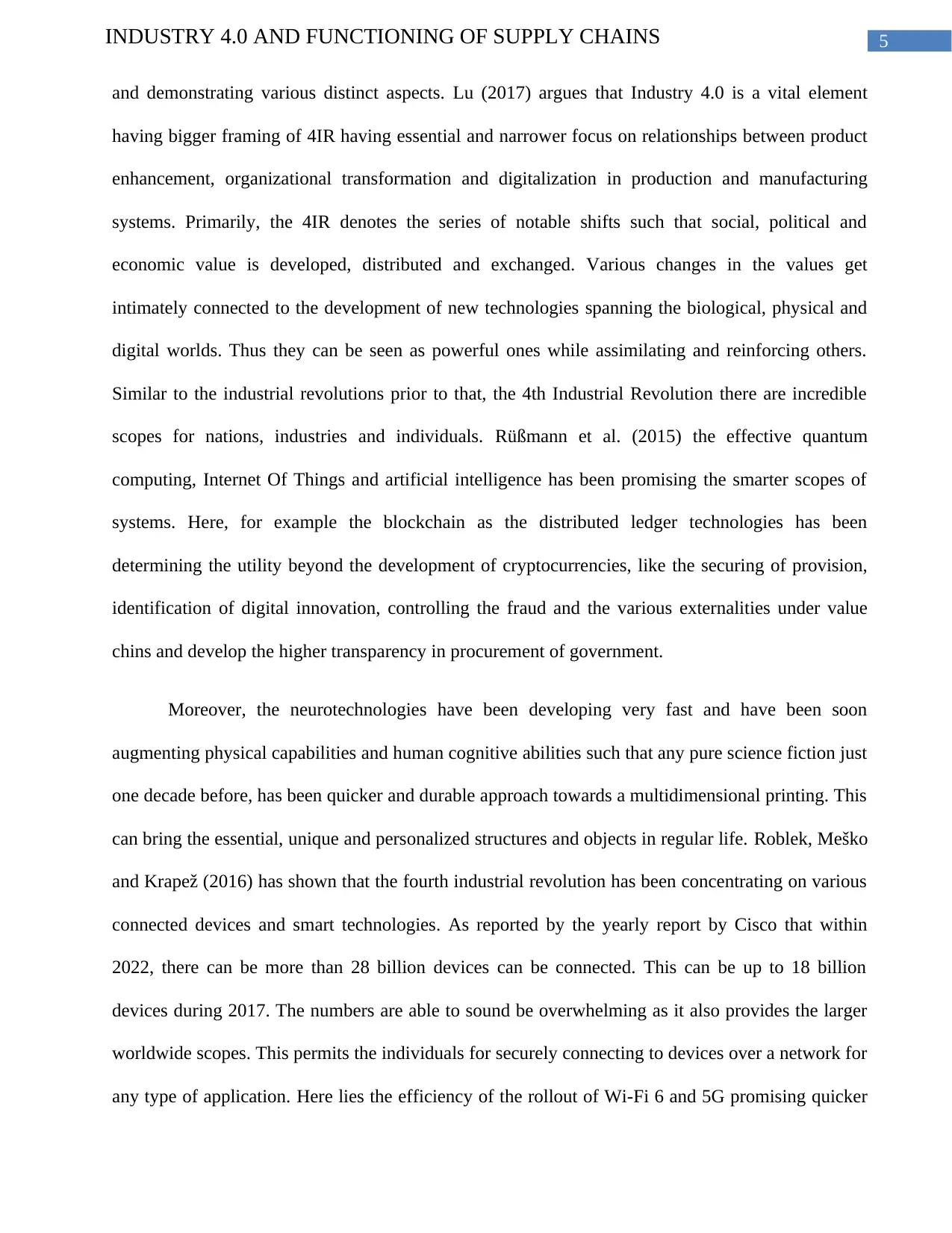
5INDUSTRY 4.0 AND FUNCTIONING OF SUPPLY CHAINS
and demonstrating various distinct aspects. Lu (2017) argues that Industry 4.0 is a vital element
having bigger framing of 4IR having essential and narrower focus on relationships between product
enhancement, organizational transformation and digitalization in production and manufacturing
systems. Primarily, the 4IR denotes the series of notable shifts such that social, political and
economic value is developed, distributed and exchanged. Various changes in the values get
intimately connected to the development of new technologies spanning the biological, physical and
digital worlds. Thus they can be seen as powerful ones while assimilating and reinforcing others.
Similar to the industrial revolutions prior to that, the 4th Industrial Revolution there are incredible
scopes for nations, industries and individuals. Rüßmann et al. (2015) the effective quantum
computing, Internet Of Things and artificial intelligence has been promising the smarter scopes of
systems. Here, for example the blockchain as the distributed ledger technologies has been
determining the utility beyond the development of cryptocurrencies, like the securing of provision,
identification of digital innovation, controlling the fraud and the various externalities under value
chins and develop the higher transparency in procurement of government.
Moreover, the neurotechnologies have been developing very fast and have been soon
augmenting physical capabilities and human cognitive abilities such that any pure science fiction just
one decade before, has been quicker and durable approach towards a multidimensional printing. This
can bring the essential, unique and personalized structures and objects in regular life. Roblek, Meško
and Krapež (2016) has shown that the fourth industrial revolution has been concentrating on various
connected devices and smart technologies. As reported by the yearly report by Cisco that within
2022, there can be more than 28 billion devices can be connected. This can be up to 18 billion
devices during 2017. The numbers are able to sound be overwhelming as it also provides the larger
worldwide scopes. This permits the individuals for securely connecting to devices over a network for
any type of application. Here lies the efficiency of the rollout of Wi-Fi 6 and 5G promising quicker
and demonstrating various distinct aspects. Lu (2017) argues that Industry 4.0 is a vital element
having bigger framing of 4IR having essential and narrower focus on relationships between product
enhancement, organizational transformation and digitalization in production and manufacturing
systems. Primarily, the 4IR denotes the series of notable shifts such that social, political and
economic value is developed, distributed and exchanged. Various changes in the values get
intimately connected to the development of new technologies spanning the biological, physical and
digital worlds. Thus they can be seen as powerful ones while assimilating and reinforcing others.
Similar to the industrial revolutions prior to that, the 4th Industrial Revolution there are incredible
scopes for nations, industries and individuals. Rüßmann et al. (2015) the effective quantum
computing, Internet Of Things and artificial intelligence has been promising the smarter scopes of
systems. Here, for example the blockchain as the distributed ledger technologies has been
determining the utility beyond the development of cryptocurrencies, like the securing of provision,
identification of digital innovation, controlling the fraud and the various externalities under value
chins and develop the higher transparency in procurement of government.
Moreover, the neurotechnologies have been developing very fast and have been soon
augmenting physical capabilities and human cognitive abilities such that any pure science fiction just
one decade before, has been quicker and durable approach towards a multidimensional printing. This
can bring the essential, unique and personalized structures and objects in regular life. Roblek, Meško
and Krapež (2016) has shown that the fourth industrial revolution has been concentrating on various
connected devices and smart technologies. As reported by the yearly report by Cisco that within
2022, there can be more than 28 billion devices can be connected. This can be up to 18 billion
devices during 2017. The numbers are able to sound be overwhelming as it also provides the larger
worldwide scopes. This permits the individuals for securely connecting to devices over a network for
any type of application. Here lies the efficiency of the rollout of Wi-Fi 6 and 5G promising quicker
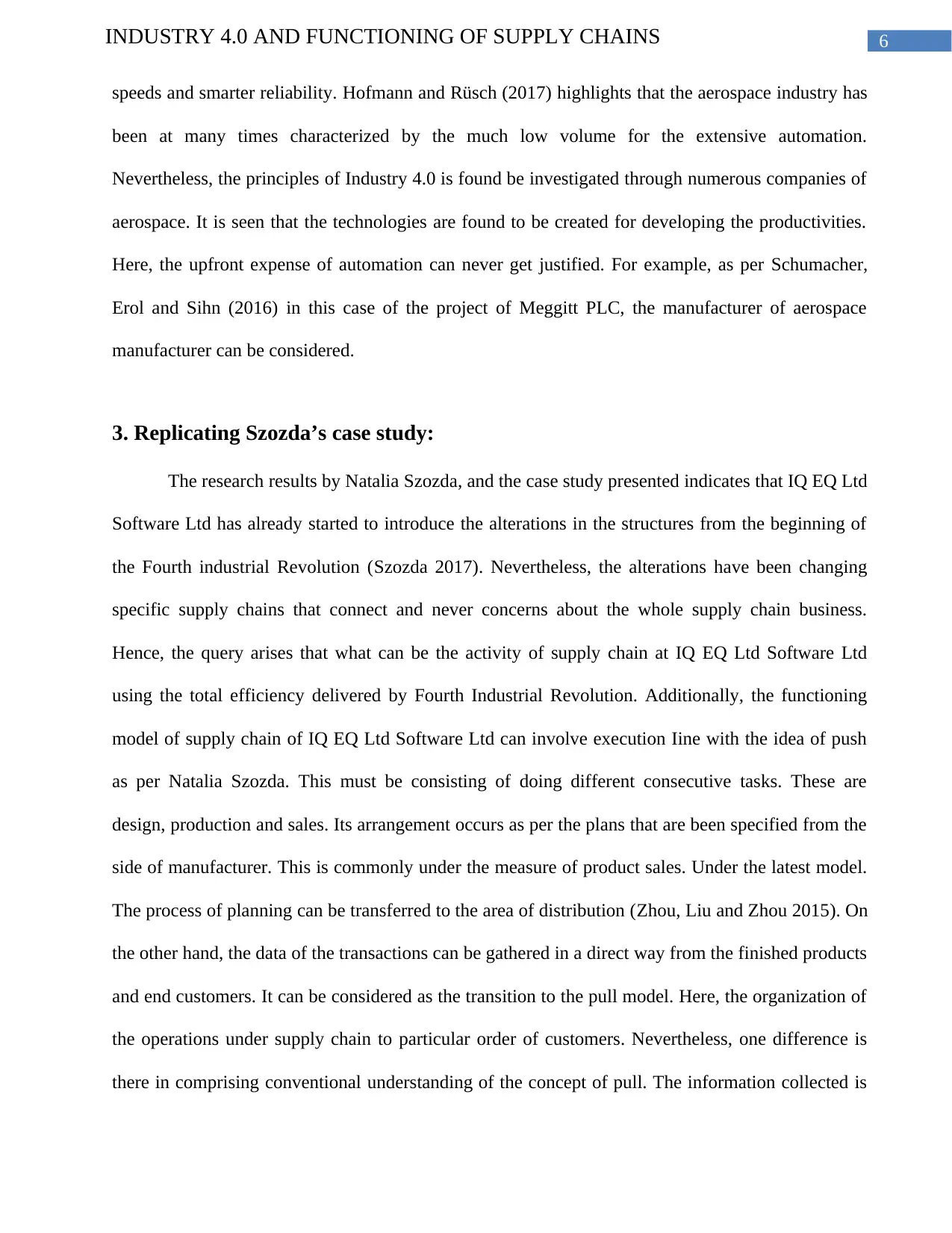
6INDUSTRY 4.0 AND FUNCTIONING OF SUPPLY CHAINS
speeds and smarter reliability. Hofmann and Rüsch (2017) highlights that the aerospace industry has
been at many times characterized by the much low volume for the extensive automation.
Nevertheless, the principles of Industry 4.0 is found be investigated through numerous companies of
aerospace. It is seen that the technologies are found to be created for developing the productivities.
Here, the upfront expense of automation can never get justified. For example, as per Schumacher,
Erol and Sihn (2016) in this case of the project of Meggitt PLC, the manufacturer of aerospace
manufacturer can be considered.
3. Replicating Szozda’s case study:
The research results by Natalia Szozda, and the case study presented indicates that IQ EQ Ltd
Software Ltd has already started to introduce the alterations in the structures from the beginning of
the Fourth industrial Revolution (Szozda 2017). Nevertheless, the alterations have been changing
specific supply chains that connect and never concerns about the whole supply chain business.
Hence, the query arises that what can be the activity of supply chain at IQ EQ Ltd Software Ltd
using the total efficiency delivered by Fourth Industrial Revolution. Additionally, the functioning
model of supply chain of IQ EQ Ltd Software Ltd can involve execution Iine with the idea of push
as per Natalia Szozda. This must be consisting of doing different consecutive tasks. These are
design, production and sales. Its arrangement occurs as per the plans that are been specified from the
side of manufacturer. This is commonly under the measure of product sales. Under the latest model.
The process of planning can be transferred to the area of distribution (Zhou, Liu and Zhou 2015). On
the other hand, the data of the transactions can be gathered in a direct way from the finished products
and end customers. It can be considered as the transition to the pull model. Here, the organization of
the operations under supply chain to particular order of customers. Nevertheless, one difference is
there in comprising conventional understanding of the concept of pull. The information collected is
speeds and smarter reliability. Hofmann and Rüsch (2017) highlights that the aerospace industry has
been at many times characterized by the much low volume for the extensive automation.
Nevertheless, the principles of Industry 4.0 is found be investigated through numerous companies of
aerospace. It is seen that the technologies are found to be created for developing the productivities.
Here, the upfront expense of automation can never get justified. For example, as per Schumacher,
Erol and Sihn (2016) in this case of the project of Meggitt PLC, the manufacturer of aerospace
manufacturer can be considered.
3. Replicating Szozda’s case study:
The research results by Natalia Szozda, and the case study presented indicates that IQ EQ Ltd
Software Ltd has already started to introduce the alterations in the structures from the beginning of
the Fourth industrial Revolution (Szozda 2017). Nevertheless, the alterations have been changing
specific supply chains that connect and never concerns about the whole supply chain business.
Hence, the query arises that what can be the activity of supply chain at IQ EQ Ltd Software Ltd
using the total efficiency delivered by Fourth Industrial Revolution. Additionally, the functioning
model of supply chain of IQ EQ Ltd Software Ltd can involve execution Iine with the idea of push
as per Natalia Szozda. This must be consisting of doing different consecutive tasks. These are
design, production and sales. Its arrangement occurs as per the plans that are been specified from the
side of manufacturer. This is commonly under the measure of product sales. Under the latest model.
The process of planning can be transferred to the area of distribution (Zhou, Liu and Zhou 2015). On
the other hand, the data of the transactions can be gathered in a direct way from the finished products
and end customers. It can be considered as the transition to the pull model. Here, the organization of
the operations under supply chain to particular order of customers. Nevertheless, one difference is
there in comprising conventional understanding of the concept of pull. The information collected is
Paraphrase This Document
Need a fresh take? Get an instant paraphrase of this document with our AI Paraphraser
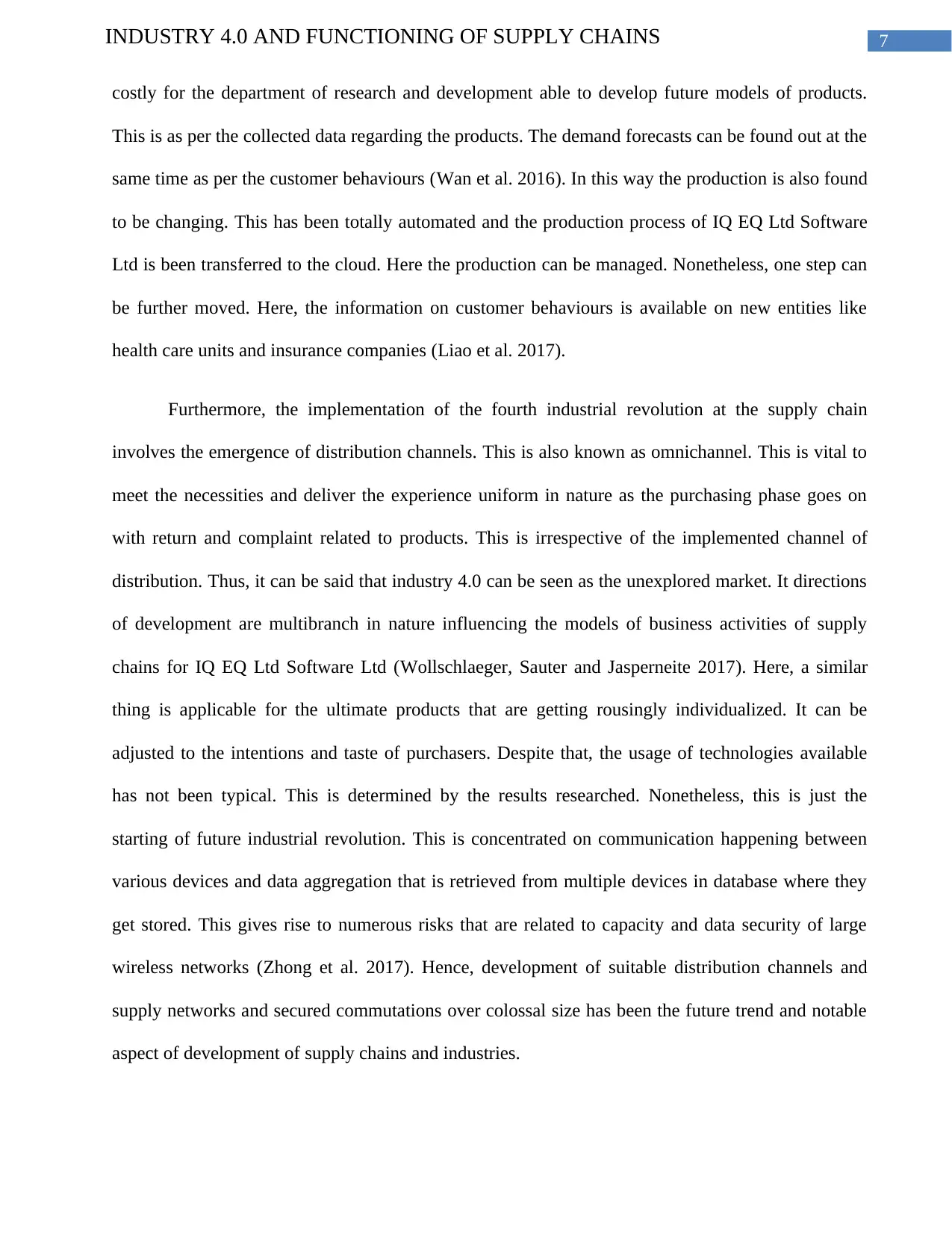
7INDUSTRY 4.0 AND FUNCTIONING OF SUPPLY CHAINS
costly for the department of research and development able to develop future models of products.
This is as per the collected data regarding the products. The demand forecasts can be found out at the
same time as per the customer behaviours (Wan et al. 2016). In this way the production is also found
to be changing. This has been totally automated and the production process of IQ EQ Ltd Software
Ltd is been transferred to the cloud. Here the production can be managed. Nonetheless, one step can
be further moved. Here, the information on customer behaviours is available on new entities like
health care units and insurance companies (Liao et al. 2017).
Furthermore, the implementation of the fourth industrial revolution at the supply chain
involves the emergence of distribution channels. This is also known as omnichannel. This is vital to
meet the necessities and deliver the experience uniform in nature as the purchasing phase goes on
with return and complaint related to products. This is irrespective of the implemented channel of
distribution. Thus, it can be said that industry 4.0 can be seen as the unexplored market. It directions
of development are multibranch in nature influencing the models of business activities of supply
chains for IQ EQ Ltd Software Ltd (Wollschlaeger, Sauter and Jasperneite 2017). Here, a similar
thing is applicable for the ultimate products that are getting rousingly individualized. It can be
adjusted to the intentions and taste of purchasers. Despite that, the usage of technologies available
has not been typical. This is determined by the results researched. Nonetheless, this is just the
starting of future industrial revolution. This is concentrated on communication happening between
various devices and data aggregation that is retrieved from multiple devices in database where they
get stored. This gives rise to numerous risks that are related to capacity and data security of large
wireless networks (Zhong et al. 2017). Hence, development of suitable distribution channels and
supply networks and secured commutations over colossal size has been the future trend and notable
aspect of development of supply chains and industries.
costly for the department of research and development able to develop future models of products.
This is as per the collected data regarding the products. The demand forecasts can be found out at the
same time as per the customer behaviours (Wan et al. 2016). In this way the production is also found
to be changing. This has been totally automated and the production process of IQ EQ Ltd Software
Ltd is been transferred to the cloud. Here the production can be managed. Nonetheless, one step can
be further moved. Here, the information on customer behaviours is available on new entities like
health care units and insurance companies (Liao et al. 2017).
Furthermore, the implementation of the fourth industrial revolution at the supply chain
involves the emergence of distribution channels. This is also known as omnichannel. This is vital to
meet the necessities and deliver the experience uniform in nature as the purchasing phase goes on
with return and complaint related to products. This is irrespective of the implemented channel of
distribution. Thus, it can be said that industry 4.0 can be seen as the unexplored market. It directions
of development are multibranch in nature influencing the models of business activities of supply
chains for IQ EQ Ltd Software Ltd (Wollschlaeger, Sauter and Jasperneite 2017). Here, a similar
thing is applicable for the ultimate products that are getting rousingly individualized. It can be
adjusted to the intentions and taste of purchasers. Despite that, the usage of technologies available
has not been typical. This is determined by the results researched. Nonetheless, this is just the
starting of future industrial revolution. This is concentrated on communication happening between
various devices and data aggregation that is retrieved from multiple devices in database where they
get stored. This gives rise to numerous risks that are related to capacity and data security of large
wireless networks (Zhong et al. 2017). Hence, development of suitable distribution channels and
supply networks and secured commutations over colossal size has been the future trend and notable
aspect of development of supply chains and industries.
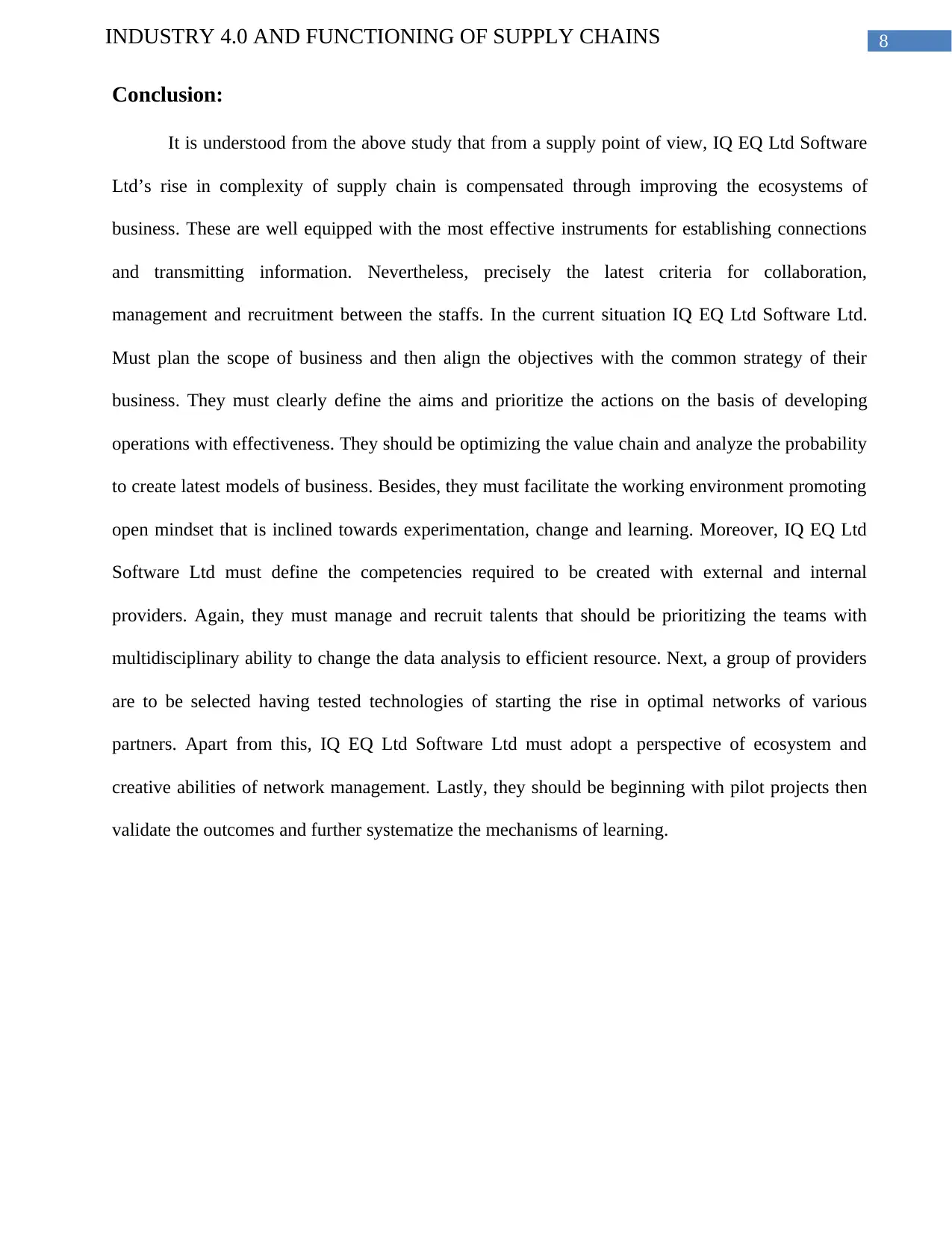
8INDUSTRY 4.0 AND FUNCTIONING OF SUPPLY CHAINS
Conclusion:
It is understood from the above study that from a supply point of view, IQ EQ Ltd Software
Ltd’s rise in complexity of supply chain is compensated through improving the ecosystems of
business. These are well equipped with the most effective instruments for establishing connections
and transmitting information. Nevertheless, precisely the latest criteria for collaboration,
management and recruitment between the staffs. In the current situation IQ EQ Ltd Software Ltd.
Must plan the scope of business and then align the objectives with the common strategy of their
business. They must clearly define the aims and prioritize the actions on the basis of developing
operations with effectiveness. They should be optimizing the value chain and analyze the probability
to create latest models of business. Besides, they must facilitate the working environment promoting
open mindset that is inclined towards experimentation, change and learning. Moreover, IQ EQ Ltd
Software Ltd must define the competencies required to be created with external and internal
providers. Again, they must manage and recruit talents that should be prioritizing the teams with
multidisciplinary ability to change the data analysis to efficient resource. Next, a group of providers
are to be selected having tested technologies of starting the rise in optimal networks of various
partners. Apart from this, IQ EQ Ltd Software Ltd must adopt a perspective of ecosystem and
creative abilities of network management. Lastly, they should be beginning with pilot projects then
validate the outcomes and further systematize the mechanisms of learning.
Conclusion:
It is understood from the above study that from a supply point of view, IQ EQ Ltd Software
Ltd’s rise in complexity of supply chain is compensated through improving the ecosystems of
business. These are well equipped with the most effective instruments for establishing connections
and transmitting information. Nevertheless, precisely the latest criteria for collaboration,
management and recruitment between the staffs. In the current situation IQ EQ Ltd Software Ltd.
Must plan the scope of business and then align the objectives with the common strategy of their
business. They must clearly define the aims and prioritize the actions on the basis of developing
operations with effectiveness. They should be optimizing the value chain and analyze the probability
to create latest models of business. Besides, they must facilitate the working environment promoting
open mindset that is inclined towards experimentation, change and learning. Moreover, IQ EQ Ltd
Software Ltd must define the competencies required to be created with external and internal
providers. Again, they must manage and recruit talents that should be prioritizing the teams with
multidisciplinary ability to change the data analysis to efficient resource. Next, a group of providers
are to be selected having tested technologies of starting the rise in optimal networks of various
partners. Apart from this, IQ EQ Ltd Software Ltd must adopt a perspective of ecosystem and
creative abilities of network management. Lastly, they should be beginning with pilot projects then
validate the outcomes and further systematize the mechanisms of learning.
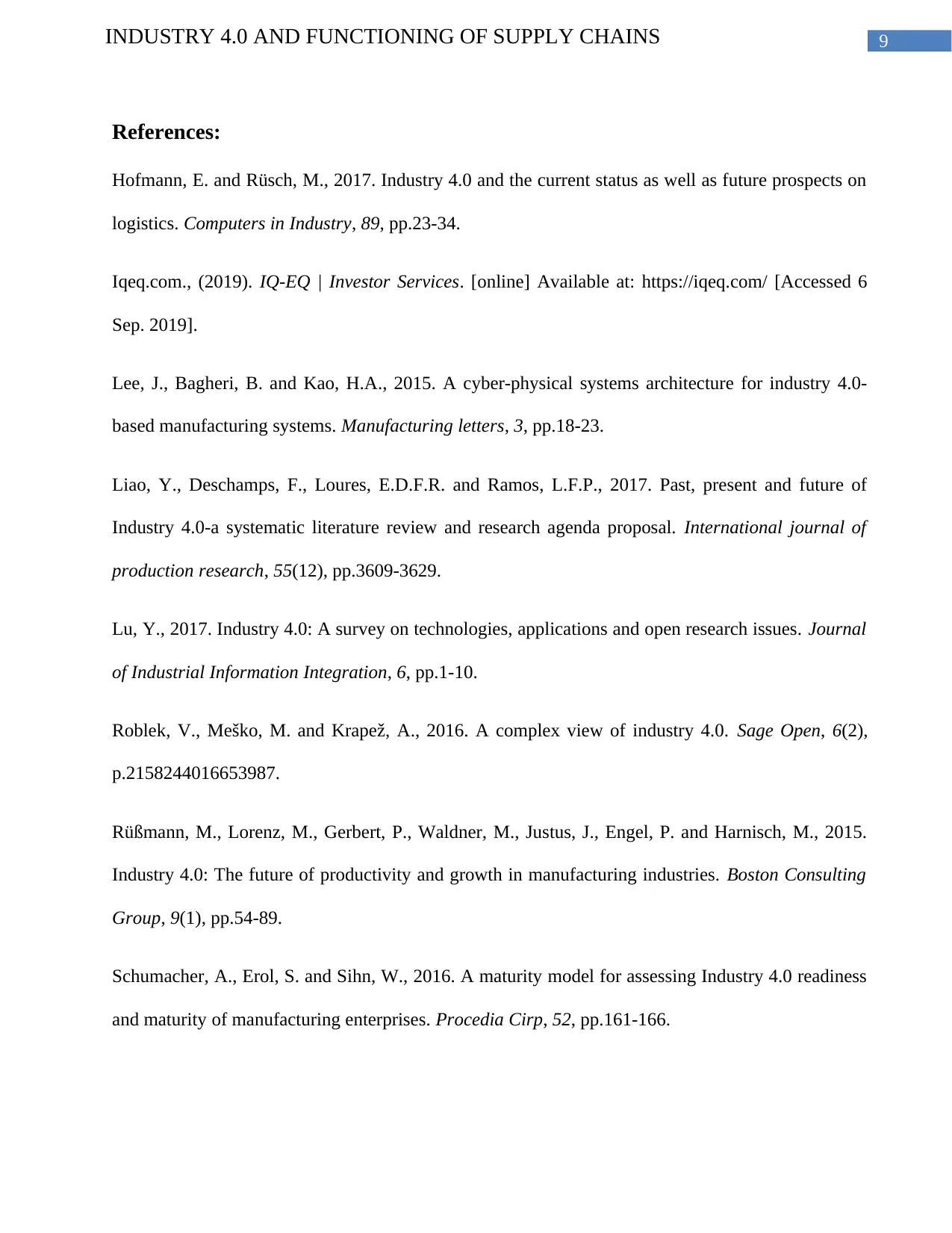
9INDUSTRY 4.0 AND FUNCTIONING OF SUPPLY CHAINS
References:
Hofmann, E. and Rüsch, M., 2017. Industry 4.0 and the current status as well as future prospects on
logistics. Computers in Industry, 89, pp.23-34.
Iqeq.com., (2019). IQ-EQ | Investor Services. [online] Available at: https://iqeq.com/ [Accessed 6
Sep. 2019].
Lee, J., Bagheri, B. and Kao, H.A., 2015. A cyber-physical systems architecture for industry 4.0-
based manufacturing systems. Manufacturing letters, 3, pp.18-23.
Liao, Y., Deschamps, F., Loures, E.D.F.R. and Ramos, L.F.P., 2017. Past, present and future of
Industry 4.0-a systematic literature review and research agenda proposal. International journal of
production research, 55(12), pp.3609-3629.
Lu, Y., 2017. Industry 4.0: A survey on technologies, applications and open research issues. Journal
of Industrial Information Integration, 6, pp.1-10.
Roblek, V., Meško, M. and Krapež, A., 2016. A complex view of industry 4.0. Sage Open, 6(2),
p.2158244016653987.
Rüßmann, M., Lorenz, M., Gerbert, P., Waldner, M., Justus, J., Engel, P. and Harnisch, M., 2015.
Industry 4.0: The future of productivity and growth in manufacturing industries. Boston Consulting
Group, 9(1), pp.54-89.
Schumacher, A., Erol, S. and Sihn, W., 2016. A maturity model for assessing Industry 4.0 readiness
and maturity of manufacturing enterprises. Procedia Cirp, 52, pp.161-166.
References:
Hofmann, E. and Rüsch, M., 2017. Industry 4.0 and the current status as well as future prospects on
logistics. Computers in Industry, 89, pp.23-34.
Iqeq.com., (2019). IQ-EQ | Investor Services. [online] Available at: https://iqeq.com/ [Accessed 6
Sep. 2019].
Lee, J., Bagheri, B. and Kao, H.A., 2015. A cyber-physical systems architecture for industry 4.0-
based manufacturing systems. Manufacturing letters, 3, pp.18-23.
Liao, Y., Deschamps, F., Loures, E.D.F.R. and Ramos, L.F.P., 2017. Past, present and future of
Industry 4.0-a systematic literature review and research agenda proposal. International journal of
production research, 55(12), pp.3609-3629.
Lu, Y., 2017. Industry 4.0: A survey on technologies, applications and open research issues. Journal
of Industrial Information Integration, 6, pp.1-10.
Roblek, V., Meško, M. and Krapež, A., 2016. A complex view of industry 4.0. Sage Open, 6(2),
p.2158244016653987.
Rüßmann, M., Lorenz, M., Gerbert, P., Waldner, M., Justus, J., Engel, P. and Harnisch, M., 2015.
Industry 4.0: The future of productivity and growth in manufacturing industries. Boston Consulting
Group, 9(1), pp.54-89.
Schumacher, A., Erol, S. and Sihn, W., 2016. A maturity model for assessing Industry 4.0 readiness
and maturity of manufacturing enterprises. Procedia Cirp, 52, pp.161-166.
Secure Best Marks with AI Grader
Need help grading? Try our AI Grader for instant feedback on your assignments.
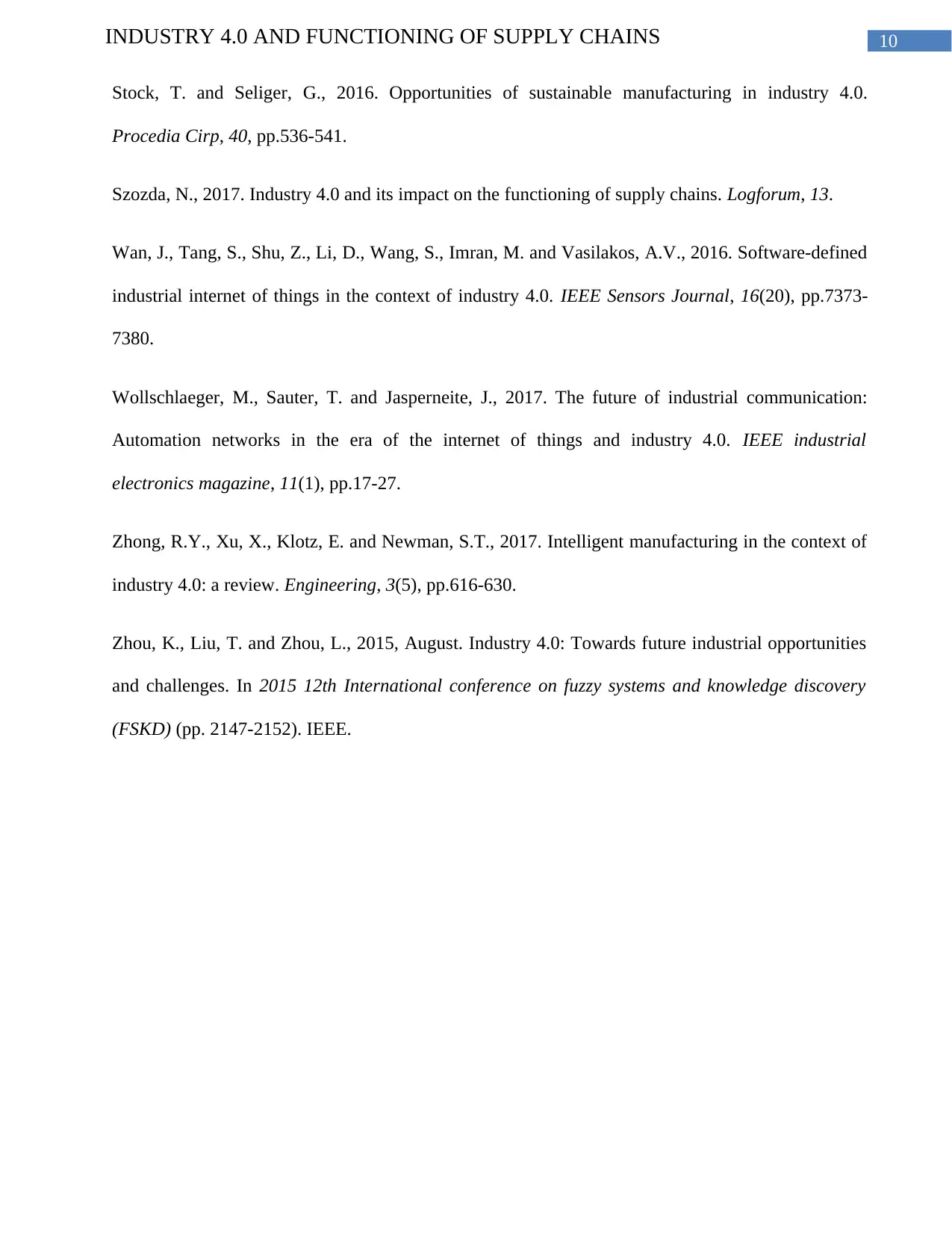
10INDUSTRY 4.0 AND FUNCTIONING OF SUPPLY CHAINS
Stock, T. and Seliger, G., 2016. Opportunities of sustainable manufacturing in industry 4.0.
Procedia Cirp, 40, pp.536-541.
Szozda, N., 2017. Industry 4.0 and its impact on the functioning of supply chains. Logforum, 13.
Wan, J., Tang, S., Shu, Z., Li, D., Wang, S., Imran, M. and Vasilakos, A.V., 2016. Software-defined
industrial internet of things in the context of industry 4.0. IEEE Sensors Journal, 16(20), pp.7373-
7380.
Wollschlaeger, M., Sauter, T. and Jasperneite, J., 2017. The future of industrial communication:
Automation networks in the era of the internet of things and industry 4.0. IEEE industrial
electronics magazine, 11(1), pp.17-27.
Zhong, R.Y., Xu, X., Klotz, E. and Newman, S.T., 2017. Intelligent manufacturing in the context of
industry 4.0: a review. Engineering, 3(5), pp.616-630.
Zhou, K., Liu, T. and Zhou, L., 2015, August. Industry 4.0: Towards future industrial opportunities
and challenges. In 2015 12th International conference on fuzzy systems and knowledge discovery
(FSKD) (pp. 2147-2152). IEEE.
Stock, T. and Seliger, G., 2016. Opportunities of sustainable manufacturing in industry 4.0.
Procedia Cirp, 40, pp.536-541.
Szozda, N., 2017. Industry 4.0 and its impact on the functioning of supply chains. Logforum, 13.
Wan, J., Tang, S., Shu, Z., Li, D., Wang, S., Imran, M. and Vasilakos, A.V., 2016. Software-defined
industrial internet of things in the context of industry 4.0. IEEE Sensors Journal, 16(20), pp.7373-
7380.
Wollschlaeger, M., Sauter, T. and Jasperneite, J., 2017. The future of industrial communication:
Automation networks in the era of the internet of things and industry 4.0. IEEE industrial
electronics magazine, 11(1), pp.17-27.
Zhong, R.Y., Xu, X., Klotz, E. and Newman, S.T., 2017. Intelligent manufacturing in the context of
industry 4.0: a review. Engineering, 3(5), pp.616-630.
Zhou, K., Liu, T. and Zhou, L., 2015, August. Industry 4.0: Towards future industrial opportunities
and challenges. In 2015 12th International conference on fuzzy systems and knowledge discovery
(FSKD) (pp. 2147-2152). IEEE.
1 out of 11
Your All-in-One AI-Powered Toolkit for Academic Success.
+13062052269
info@desklib.com
Available 24*7 on WhatsApp / Email
![[object Object]](/_next/static/media/star-bottom.7253800d.svg)
Unlock your academic potential
© 2024 | Zucol Services PVT LTD | All rights reserved.